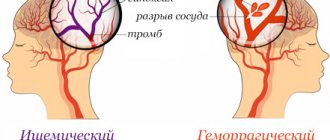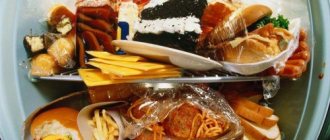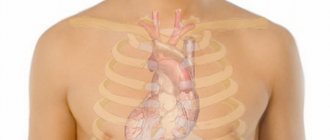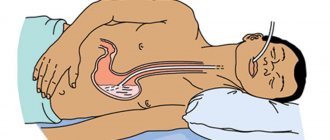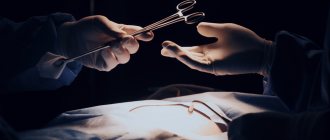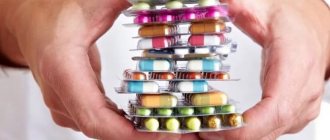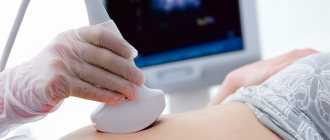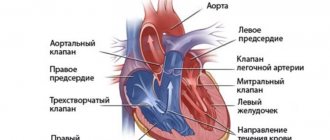Ischemic stroke has several stages of progression. The first stage is an acute period of ischemic stroke, which lasts up to the 21st day. During the first 3-5 days, perifocal cerebral edema develops, karyoplasmic and cytoplasmic cells shrink.
An important point in the acute period of ischemic stroke is to correctly diagnose. First of all, it is necessary to distinguish any other diseases of the nervous system from a stroke. Next, the nature of the stroke itself is determined, and what caused it (hemorrhage in the cerebral cortex or blood clot). At the last stage of diagnosis, the localization of the lesion is determined, as well as the pathogenesis of cerebral infarction during stroke.
Stages of diagnostics of the acute period
- Stage 1. The victim is urgently hospitalized. The doctor receives basic information from the words of the patient, his relatives or surrounding people. External signs of cerebral circulatory disorders, emotional background, physical stress, and blood pressure levels allow a diagnosis to be made fairly quickly and accurately. The patient's medical history is studied for the presence of other diseases that can provoke the development of ischemic stroke (arrhythmia, atherosclerosis, previous heart attack, etc.). However, the possibility of making an incorrect diagnosis exists in the case of an epileptic seizure, a brain tumor, a head injury, a hypoglycemic state, etc.
- Stage 2. The most important point of this stage is to quickly and accurately determine the nature of the disease. The tactics of first aid and further treatment will depend on this. A computed tomography scan of the brain is performed, since the clinical picture alone cannot provide completely reliable information.
- Stage 3. After a quick history has been collected, the clinical picture has been identified and a CT scan has been performed, the doctor begins to choose treatment tactics. The subtype of stroke is also determined (lacunar, atherothrombotic or cardioembolic, etc.). The correct choice of therapy will help not only provide timely assistance to the victim, including surgery, but also prevent a possible recurrence of a heart attack in the future.
Selected most critical time periods
Doctors have developed some statistics that have made it possible to determine certain periods of time that are most dangerous to the life of a patient who has suffered a stroke. The most dangerous period is the first two days after the onset of a cerebral catastrophe.
Also, the risk increases significantly on days 7-10 and 14-21 after the pathology has occurred. The percentage statistics for deaths are as follows:
- 1st day – 45.9%;
- 7th day – 24.5%
- 14th day – 17.3%
- 21st day – 12.2%.
That is why back in the 60-70s. The World Health Organization has identified a 21-day period as the most critical period for the life of a person who has suffered a stroke. After active recovery and properly prescribed therapy, the situation begins to improve and the person gets better.
Therapy for ischemic stroke in the acute period
In the first three weeks (during the acute period), general measures are taken:
- The required oxygen level is maintained;
- Blood pressure stabilizes;
- Cardiac activity is under medical supervision;
- The condition of the bladder and intestines is monitored;
- Passive gymnastics is carried out on all limbs of the victim;
- Prevention of bedsores;
- Antibacterial therapy, including taking antifungal drugs.
Depending on the specifics and subtype of ischemic stroke, special therapy is carried out.
Acute ischemic stroke may recur if the diagnosis is not reliable and not all emergency measures have been taken. In the acute period, secondary hemorrhage into damaged tissue of the cerebral cortex poses a great danger. As a rule, this occurs in the first 10 days after the onset of a stroke. It is almost impossible to detect this complication visually. Only with the help of computed tomography and x-ray examination do they find a new lesion and take action. The reason for this complication is the lack of necessary control over blood pressure, as well as reperfusion therapy. Some patients have serious contraindications for it.
Signs of a stroke
Even if these symptoms appear and disappear, you need to seek medical help as soon as possible:/p>
- unsynchronized smile, distortion of half the face;
- an unsuccessful attempt to stick out the tongue - the organ has an uneven shape and “sinks”;
- unclear, confused speech, inability to pronounce simple phrases;
- “heavy” head, dizziness;
- sudden weakness of one half of the body;
- paralysis of limbs, face;
- progressive “stiffness” of the muscles (especially in the neck);
- lack of coordination, unsteady gait;
sudden numbness, tingling in the face, arms, legs;
- blurred vision, difficulty focusing;
- inability to look at a bright light source;
- convulsions;
- vomiting, nausea;
- difficulty swallowing;
- shortness of breath;
- loss of memory, consciousness.
With an aneurysm, the first symptom is a severe headache, as well as vomiting, spasms of the neck muscles, and confusion.
Risk factors
- high pressure;
- overweight;
- atrial fibrillation - irregular heartbeats provoke the formation of blood clots, which can then migrate to the brain, which increases the risk of stroke by 5 times;
- diabetes – the disease weakens blood vessels, causing the formation of emboli;
- physical inactivity;
- smoking – thickens the blood, which leads to blood clots;
- high cholesterol – provokes the formation of atherosclerotic plaques;
- gender – stroke is diagnosed more often in men, but mortality is higher in women;
- sleep disorders - due to apnea, insomnia, the brain does not have the opportunity to recover;
- vitamin D deficiency;
- increased blood clotting;
- genetic predisposition to heart disease, hypertension, diabetes;
- Fabry disease;
- blood vessel abnormalities;
- Alcohol abuse – liver dysfunction increases the risk of stroke;
- excessive consumption of artificial sweeteners (including diet soft drinks);
- taking drugs (cocaine, heroin, amphetamines).
Stroke treatment
Tomography (computer and magnetic resonance imaging) can help diagnose a stroke. If an embolism is suspected, a lumbar puncture is performed. If CT or MRI cannot be performed for some reason, echoencephalography is performed.
It is necessary to act quickly - the sooner therapy begins, the higher the chances of saving life and restoring functionality. Ideally, you need to get to a medical facility within the first hour after a stroke. Prompt restoration of blood supply and oxygen supply to the brain gives a chance for full recovery. Before the ambulance arrives, you should not take food or water, so as not to provoke suffocation in case of paralysis of the swallowing organs and the risk of food getting into the respiratory tract. For the same purpose, when vomiting, the patient's head should be turned to the side. The head and shoulders should be on the same line, you can put a pillow (the angle should not exceed 30°). Avoid sudden, intense movements and remove tight clothing. In case of loss of consciousness or lack of rhythmic breathing, cardiopulmonary resuscitation is necessary, including the use of a defibrillator.
In a medical institution, therapy is carried out according to appropriate protocols. For ischemic stroke, drugs are used that destroy blood clots and improve blood flow. In some cases, emboli must be removed surgically (usually with a catheter inserted into an artery in the groin area).
For hemorrhagic stroke, medications are given to prevent clots from forming. Surgery may also be required. During the period of bed rest, it is important to monitor the condition of the respiratory system, preventing the development of pneumonia, and also to avoid the appearance of bedsores by promptly changing underwear, doing massage, and often turning the patient over.
Recovery time after hemorrhagic stroke
The rehabilitation performed after such a brain injury consists of several stages:
- early period, lasting about six months after the attack;
- later recovery, lasting from six months to 1 year;
- the stage of final recovery, which in its duration occupies the entire subsequent time.
A year after the attack, residual effects begin. The best results during rehabilitation can be obtained in the first year; for this reason, recovery should not be delayed.
Effective results are obtained by strictly observing the following important principles:
- taking action at an early stage of ongoing treatment in a hospital;
- daily implementation by the patient of appropriate recommendations without any delays;
- prescribing special physical activity with appropriate intensity and gradual complication of exercises.
In addition, it is very important to take comprehensive measures: prescribing physiotherapy, drug treatment and the necessary correction of the patient’s psychological state. During this period, a recovering person must protect himself from unnecessary stressful situations, and also be surrounded by the care and love of family and friends.
The danger of a recurrent attack and how to behave
After primary ischemia has occurred, the risk of a second brain stroke increases significantly. In almost 70% of cases, relapses lead to death. And no matter how much time passes from the moment of the attack, it will not be possible to definitely get rid of the risk of relapse. The most dangerous in terms of the risk of relapse is the 1st year after the attack.
To reduce the risks during critical days and reduce the likelihood of relapse, it is necessary to develop the right behavior strategy. A brain stroke in any form always requires immediate hospitalization in a medical institution that has the necessary diagnostic and treatment equipment. Often, after an attack, it may be necessary to carry out competent resuscitation measures.
What can be accompanied by acute moments after an attack?
After a stroke occurs, the patient often experiences serious changes both physically and psychologically. Most often, during the acute phase of an attack, severe stress occurs, which becomes a serious test for the nervous system. Vision and memory deteriorate, and loss of consciousness is possible. Motor functions may be severely affected.
Independent restoration of the normal functioning of body systems after a stroke can take a very long period of time and sometimes does not occur at all. It is vital for the body to restore such necessary functions as contraction of the heart muscle and the establishment of respiratory movements. If the respiratory area, which is responsible for conscious movements, is affected, the floor of the body may be affected.
It is important to know that the nerve cells that make up neurons are not capable of dividing. Therefore, in the case of any brain damage, the tissue may not even recover. Sometimes their functionality is taken over by unaffected neighboring cells, but full functioning can no longer be ensured.
At critical points after a stroke, the patient’s relatives must completely trust the doctors, and also be as attentive as possible to the well-being of the victim. In case of the slightest change in the patient’s condition, it is necessary to immediately report the information to doctors. In this way, risks can be minimized during critical periods and aid in rapid recovery.
An experienced specialist can, based on the symptoms of each stroke patient, subsequently tell which part of the brain was affected by the attack. This approach will make it possible to predict the subsequent course of the disease and possible critical moments.

